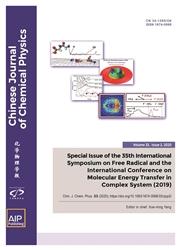Theoretical study on organic photovoltaic heterojunction FTAZ/IDCIC
IF 1.2
4区 化学
Q4 PHYSICS, ATOMIC, MOLECULAR & CHEMICAL
引用次数: 1
Abstract
Understanding organic photovoltaic (OPV) work principles and the materials’ optoelectronic properties is fundamental for developing novel heterojunction materials with the aim of improving power conversion efficiency (PCE) of organic solar cells. Here, in order to understand the PCE performance (>13%) of OPV device composed of the non-fullerene acceptor fusing naphtho[1,2-b:5,6-b′]dithiophene with two thieno[3,2-b]thiophene (IDCIC) and the polymer donor fluorobenzotriazole (FTAZ), with the aid of extensive quantum chemistry calculations, we investigated the geometries, molecular orbitals, excitations, electrostatic potentials, transferred charges and charge transfer distances of FTAZ, IDCIC and their complexes with face-on configurations, which was constructed as heterojunction interface model. The results indicate that, the prominent OPV performance of FTAZ:IDCIC heterojunction is caused by co-planarity between the donor and acceptor fragments in IDCIC, the the charge transfer (CT) and hybrid excitations of FTAZ and IDCIC, the complementary optical absorptions in visible region, and the large electrostatic potential difference between FTAZ and IDCIC. The electronic structures and excitations of FTAZ/IDCIC complexes suggest that exciton dissociation can fulfill through the decay of local excitation exciton in acceptor by means of hole transfer, which is quite different from the OPVs based on fullerenes acceptor. The rates of exciton dissociation, charge recombination and CT processes, which were evaluated by Marcus theory, support the efficient exciton dissociation that is also responsible for good photovoltaic performance.有机光伏异质结FTAZ/IDCIC的理论研究
了解有机光伏(OPV)的工作原理和材料的光电特性是开发新型异质结材料以提高有机太阳能电池的功率转换效率的基础。为了了解由非富勒烯受体融合萘并[1,2-b:5,6-b′]二噻吩与两个噻吩并[3,2-b]噻吩(IDCIC)和聚合物供体氟苯并三唑(FTAZ)组成的OPV器件的PCE性能(>13%),我们借助于广泛的量子化学计算,FTAZ、IDCIC及其具有面上构型的配合物的转移电荷和电荷转移距离,构建了异质结界面模型。结果表明,FTAZ:IDCIC异质结突出的OPV性能是由IDCIC中供体和受体片段之间的共平面性、FTAZ和IDCIC的电荷转移(CT)和混合激发、可见光区域的互补光学吸收以及FTAZ与IDCIC之间的大静电电势差引起的。FTAZ/IDCIC配合物的电子结构和激发表明,激子离解可以通过空穴转移的方式通过受体中局部激发激子的衰变来实现,这与基于富勒烯受体的OPV截然不同。Marcus理论评估的激子离解率、电荷复合率和CT过程支持有效的激子离解,这也是良好光伏性能的原因。
本文章由计算机程序翻译,如有差异,请以英文原文为准。
求助全文
约1分钟内获得全文
求助全文
来源期刊

Chinese Journal of Chemical Physics
物理-物理:原子、分子和化学物理
CiteScore
1.90
自引率
10.00%
发文量
2763
审稿时长
3 months
期刊介绍:
Chinese Journal of Chemical Physics (CJCP) aims to bridge atomic and molecular level research in broad scope for disciplines in chemistry, physics, material science and life sciences, including the following:
Theoretical Methods, Algorithms, Statistical and Quantum Chemistry
Gas Phase Dynamics and Structure: Spectroscopy, Molecular Interactions, Scattering, Photochemistry
Condensed Phase Dynamics, Structure, and Thermodynamics: Spectroscopy, Reactions, and Relaxation Processes
Surfaces, Interfaces, Single Molecules, Materials and Nanosciences
Polymers, Biopolymers, and Complex Systems
Other related topics
 求助内容:
求助内容: 应助结果提醒方式:
应助结果提醒方式:


